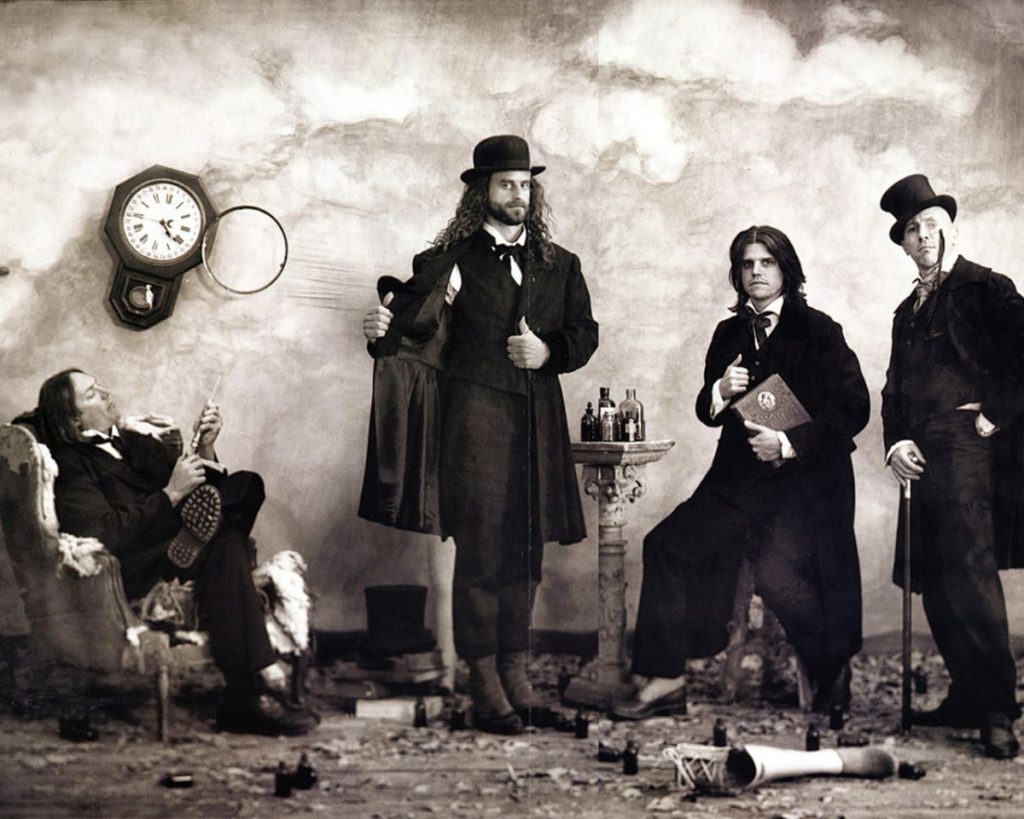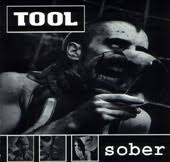Sob Story – Tool Will Give You Something To Cry About
Cover Story Published in BAM Magazine

“Do for others what you want them to do for you.” -Matthew 7:12
“Do unto others what has been done to you.” -“Prison Sex,” from Tool’s Undertow CD
Little did Jesus’ disciple realize when he wrote one of the Bible’s golden rules that his words would become the main thrust in a song about sodomy. “Prison Sex,” which hides innocently between tracks one and three on Tool’s debut Zoo Entertainment LP, Undertow, may be the most twisted piece of musical psychology since Jim Morrison cried for his mother’s affections in “The End.”
“Prison Sex” opens with a brief back history. A boy is sexually molested. By whom? We’re not told. Why? Who ever knows. The boy, now grown and incarcerated, appears justifiably angry at his lot in life. Not content with self-loathing, however, the character intends to make an angry point inside the posterior of an unwitting cellmate. “Ree-lease in sodomy,” sings the prisoner, played by vocalist Maynard James Keenan. The music swirls around the prison cell like a fly looking for a meal, full of piercing melody and pent-up bursts of speed. Meanwhile, Keenan hums the “Do unto others…” phrase like a brutal mantra. Finally, the violation is complete, and the raped man lies motionless. “I have found some kind of temporary sanity,” Keenan sings through gritted teeth. Yet, as the moment of satisfaction quickly fades and the sublime crescendo of guitars, bass, and drums falls to eerie silence, there hands in the air the most disturbing feeling that, despite what he’d hoped to achieve or alleviate, the violator is still lost, still a prisoner, and, ultimately, still fucked.
Tool is not a band that takes life lightly. Nor are they the latest in a long line of Johnny-whine-lately acts full of adolescent rage because their parents refused to buy them Lucky Charms. Tool is different. The band explores the darkest, most disturbing aspects of human behavior, with the power and fascination of a child feeling the cool edge of a razor for the first time. On the first listen, one might lump the band in with that group of heady, chunk-metal bands-Helmet, Paw, Tar, etc.–whose similar styles and one word monikers have spawned a genre that LA Times’ Jonathon Gold called “noun rock.” Those who do, would be wrong. “We’re a verb,” asserts Keenan.
The band may be driven to action, but Tool is definitely not for the short-attention-span thrash lovers who embrace a physical confrontation through the latest Pantera CD or heavy poli-sci lessons via Rage Against the Machine. Tool wants to get in your face, pick your brain, and unearth the psychological dirt covering human conduct. “I don’t really like to put the word ‘therapy’ on our music, because it makes you sound dysfunctional or something,” said the surprisingly soft-spoken singer. “But, if [Tool] takes the listener beyond where they normally are, opens them up to new experiences and new correlations they make with the life force in general, then fine. But, we’re not looking to become some kind of figurehead or martyr or leader.”
In fact, the four members of Tool–including former Pygmy Love Circus drummer Danny Carey, nimble guitarist Adam Jones, and bomb-dropping bassist Paul D’Amour–created the band as a tool to unleash aggression…legally. “It began as a self-satisfying thing for us,” admits Carey. “Our music was a release and a vehicle to get out whatever tensions we were feeling at that time.” The music is not a noisy din of tinny snare drums and three-chord guitar sputters; instead, Tool summons a variety of influences–a chunk of early Rush here, a bit of Sabbath there, a small slice of King Crimson way out there, and a Marshall stackful of Metallica everywhere. The sound gels in one ordered structure that “begins in harmony, departs, and the comes back together,” describes Keenan.
“There’s an attitude that’s conveyed in Maynard’s voice that’s very clear, distinctive, and melodic,” explains Lou Maglia, president of Tool’s label, Zoo Entertainment. “Then, as if out of nowhere, his voice suddenly gives in to this screaming rage like he’s ready to throw up from what’s going on inside himself.”
“Contrasts,” Keenan says simply of his style. “You need contrasts.”
The band also like to run with the listener’s preconceived perceptions of music. “Disgustipated,” the new album’s closer, runs15-and-a-half minutes long, and begins with a farmer performing a sacrificial ceremony on a bunch of harvested carrots. The cries of the vegetables segue to the sound of chirping crickets for no less than seven minutes. No words, no instruments, no humans; only those creaking crickets, chirping their little heads off until their once-comforting stridulations take on a violent, horrifying moan. (“That’s what it’s all about,” Keenan explains. “Seeing things differently, seeing things how you never have before.”) The final part of this quiet epic is a brief phone message left by a serial killer who describes, in lurid detail, the bloody plight of this latest victim. Listen to the track in your car on a deserted highway and the chills will remain throughout the drive home.
The contrast of dark humor with disturbing imagery makes the piece poignantly powerful. “There’s a lot of humor in our work that’s lost on people,” Keenan admits.”Much of what we do is a big, ‘Fuck you!’ to the industry.”
The Hustler photo studios are located in Culver City, amid acavalcade of other entertainment production facilities. A mere hundred yards from the set where child actor Fred Savage discovered the joys of growing up on TV’s The Wonder Years, Hustler magazine continues to shoot naked men and women locked in jaw-breaking passion for hours on end. The studio also doubles as a photo house for another of publisher Larry Flynt’s magazines, the music maverick RIP.
One day last summer, Tool was being shot for that magazine, when the free-lance photographer asked Keenan to slip into a T-shirt with the RIP logo emblazoned across the chest. Keenan refused. The photographer’s argumentations could be heard from the adjacent studios as he insisted that wearing the RIP shirt would be good publicity for the band. “I told him, ‘Fuck no! There’s no way in hellI’m gonna wear your shit,'” Keenan recalls. “This isn’t about good publicity or selling fucking magazines; that’s not what we want todo. That would be dishonest.”
And honesty has thus far paid off well. Tool will soon end a breakthrough year that began with the release of its debut LP Undertow last April. (The six-song EP, Opiate, arrived in 1992.) After several showcases in LA, the band nabbed the opening slot on last summer’s Lollapalooza extravaganza, and saw album sales slowly increase until the first video, “Sober,” became an across-the-board success on MTV.

Having aired on shows as disparate as Headbanger’s Ball, Alternative Nation, and the Beavis & Butt-head heave-o-rama, the “Sober” clip has helped push Undertow near exalted gold status. The”Sober” vignette depicts a highly stylized Claymation image of an old man languishing in an industrial basement setting that makes Eraserhead’s apartment seem downright homey.
The visuals, conceived by guitarist Jones and directed by Fred Stuhr (who created Green Jelly’s groundbreaking clip, “Three Little Pigs”), have an almost transcendent sense of despair. Against a soaring melody and steely bottom end, the old man searches endlessly–in closets, behind doors, and even inside rusted pipes filled with pulsing arteries–for something he never finds.
BAM: What’s wrong with that little man?
Keenan: What’s wrong with him?
BAM: Yeah. What’s he looking for?
Keenan: That…place, I guess.
BAM: Will he ever find that place? [Silence] Maybe yes? Maybe no Crapshoot?
Keenan: Crapshoot.
Talking with Keenan is, itself, a crapshoot and an ode to frustration. The 29-year-old singer speaks in muted tones that, by comparison, make Lyle Lovett sound like the late Sam Kinison. Bill Manspeaker, leader of goofball rockers Green Jelly and a former roommate of Keenan’s, likens the Tool singer to the surly Eddie Haskell character on Leave It to Beaver. “He’s always grumpy,” Manspeaker laughs about Keenan’s demeanor. “Not grumpy in a bad way, but grumpy like one of the Seven Dwarves.”
Keenan disagrees with that analogy, and admits his metaphysical glass can be either half-empty or half-full, “depending on what I’m drinking.” Realizing the interview process is a necessary evil of his job, Keenan still loathes the interrogation procedure.
BAM: Do you consider interviews the worst part of your “job”?
Keenan: Other than dealing with promoters, yes.
BAM: I take it you’re not the kind of person who likes talking about himself.
Keenan: No. Never have been. So, to have to do that now on an almost daily basis is really a struggle for me.
BAM: I’ll go easy on you. How long have you lived in LA?
Keenan: Three years.
BAM: Your bio says you moved here from Michigan.
Keenan: Actually, I moved here from Boston.
BAM: So, you were born in Michigan and then moved to Boston.
Keenan: No, I was born in Ohio.
BAM: You moved a lot.
Keenan: I lived all over the States. There’s no way to pinpoint exactly where I’m from. Just say I’m from the States, and I live in LA now.
BAM: So, did your parents have a nomadic background because of a job or something…?
Keenan: No, not necessarily. I just had a nomadic background myself.
BAM: Because of…
Keenan: Circumstances.
BAM: Anything you care to talk about?
Keenan: No.
BAM: What would’ve happened if you wouldn’t have gotten out from wherever you were born?
Keenan: Oh, I would’ve gotten out. I have no doubt about that. No matter what, I would’ve gotten out.
“In some cases, there’ve been people I’ve wanted to kill,” says Tool drummer Carey, owner of a 12-gauge shotgun. “I’ve been so angry, I’d think about it for weeks. I’d think about it over and over in my head, imagining the job being done and imagining the scenario. To put that feeling into a song really makes me feel better.”
Tool’s view of humanity is grim, to say the least. Ask Keenan if he hates people, and he responds, “Pretty much, I would have to say absolutely.”
Why?
“Ignorance,” he says and leaves it at that.
Keenan discovered ignorance first-hand during a three year stint in the Army that taught him “a lot about the lowest common denominator for human behavior when trapped in closed quarters.” Whatever the “Circumstances” that spurred his nomadic childhood, it’s apparent that some of his military experiences bashed their way into Tool songs, including, one might guess, “Prison Sex.” Dig…
“You’d think that integration would end up breaking down barriers,” Keenan recalls of his Army life, “but all it does is strengthen them. It’s pretty sad. Then again, the people put in the room together are pretty much poisoned before they get there, so then they see a stereotype, and they hate that guy even more now… But [homosexuals] are humans and being gay is just the way they are. As soon as we figure out that this [homosexuality] is a part of some humans and has been an integral part of our society as long as we’ve been in existence, the sooner we can accept that and get on to evolving.”
In the summer of 1948, Ronald P. Vincent, a crop-spray contractor, moved from Kansas to Hollywood after his wife had been dismembered in a bizarre snow plough accident. Inspired buy the unrelenting pain he felt, Vincent penned his first and only book, A Joyful Guide to Lachrymology (Lachrymology means, “the study of crying”), a guide to feeding off pain and channeling the negative energy toward positive means, similar to the theories advanced in Freud’s The Pleasure and Pain Principle. Vincent’s book became a revelation in Tool guitarist Adam Jones’s life and spurred his desire to form a musical act that could channel his own frustrations into art. All four band members have used the lachrymology principles as a sort of personal religion and assimilated much of its ideology into their songs. “The philosophy of that book is basically using your pain to a profit, rather than letting it drag you down,” explains Carey. “A lot of people who can’t master that art end up jumping off buildings.”
The book also, like many of Tool’s songs, including the title track “Opiate” and “Sober,” eschews the blind faith required by organized religion, dealing instead with what is here and now and tangible. “We’re all searching for the same answers,” says Carey. “Why we’re here; where we’re going; what’s the point. It’s the ones who claim to know the answers, the ones who get on their soapboxes and shout about it, however, that I think are the furthest from the truth, furthest from knowing the answers.”
The Scientology Garden Pavilion in Hollywood is the epitome of silent lucidity. It’s creator, the late L. Ron Hubbard, author of the quasi-religious tome Dyanetics, made a profitable living proving that people’s problems can only be overcome through his New Age ideologies. In the center of this placid oasis stands the Celebrity Center, a glass gazebo where, last May, Tool used the solemn surroundings as an ironic forum for its own dynamic principles of finding inner strength. Between songs, Keenan, staring first at the lush grounds paid for by devoted L. Ron followers and then into the eyes of his own audience, bayed into the mic like a sheep looking for his shepherd’s gate. “Baaaaa! Baaaaa!” the singer bleated. The subordinate call could be heard as far away as Franklin Avenue, where the boulevard congregation bummed spare change. A minutes later, the band blasted into “Swamp Song,” Keenan railing against the “belligerent fuckers” who keep the Everyman down. Jones shredded notes with his guitar, while bassist D’Amour and drummer Carey dropped smart bombs on the compound. The melody was so heavy, God, Himself, probably donned earplugs and considered finally fulfilling His promise of returning, if only to save His creation from itself.
This is the setting where Tool thrives, away from interviews, promoters, and pesky photographers. When delivering its music, the band reveals a beneficial purpose, both to itself and its followers: Gaining strength through a common bond while opening the mind to new insights; precisely the principle on which great religions have been founded.
